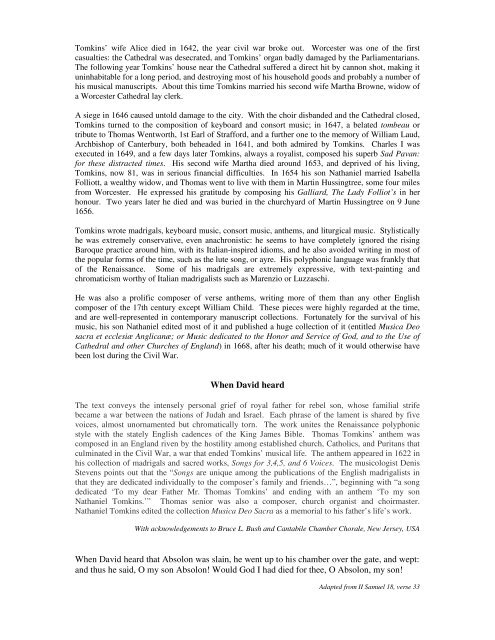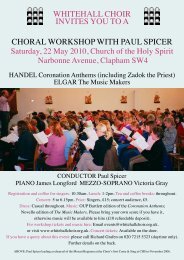Create successful ePaper yourself
Turn your PDF publications into a flip-book with our unique Google optimized e-Paper software.
Tomkins’ wife Alice died in 1642, the year civil war broke out. Worcester was one of the firstcasualties: the Cathedral was desecrated, and Tomkins’ organ badly damaged by the Parliamentarians.The following year Tomkins’ house near the Cathedral suffered a direct hit by cannon shot, making ituninhabitable for a long period, and destroying most of his household goods and probably a number ofhis musical manuscripts. About this time Tomkins married his second wife Martha Browne, widow ofa Worcester Cathedral lay clerk.A siege in 1646 caused untold damage to the city. With the choir disbanded and the Cathedral closed,Tomkins turned to the composition of keyboard and consort music; in 1647, a belated tombeau ortribute to Thomas Wentworth, 1st Earl of Strafford, and a further one to the memory of William Laud,Archbishop of Canterbury, both beheaded in 1641, and both admired by Tomkins. Charles I wasexecuted in 1649, and a few days later Tomkins, always a royalist, composed his superb Sad Pavan:for these distracted times. His second wife Martha died around 1653, and deprived of his living,Tomkins, now 81, was in serious financial difficulties. In 1654 his son Nathaniel married IsabellaFolliott, a wealthy widow, and Thomas went to live with them in Martin Hussingtree, some four milesfrom Worcester. He expressed his gratitude by composing his Galliard, The Lady Folliot’s in herhonour. Two years later he died and was buried in the churchyard of Martin Hussingtree on 9 June1656.Tomkins wrote madrigals, keyboard music, consort music, anthems, and liturgical music. Stylisticallyhe was extremely conservative, even anachronistic: he seems to have completely ignored the risingBaroque practice around him, with its Italian-inspired idioms, and he also avoided writing in most ofthe popular forms of the time, such as the lute song, or ayre. His polyphonic language was frankly thatof the Renaissance. Some of his madrigals are extremely expressive, with text-painting andchromaticism worthy of Italian madrigalists such as Marenzio or Luzzaschi.He was also a prolific composer of verse anthems, writing more of them than any other Englishcomposer of the 17th century except William Child. These pieces were highly regarded at the time,and are well-represented in contemporary manuscript collections. Fortunately for the survival of hismusic, his son Nathaniel edited most of it and published a huge collection of it (entitled Musica Deosacra et ecclesiæ Anglicanæ; or Music dedicated to the Honor and Service of God, and to the Use ofCathedral and other Churches of England) in 1668, after his death; much of it would otherwise havebeen lost during the Civil War.When David heardThe text conveys the intensely personal grief of royal father for rebel son, whose familial strifebecame a war between the nations of Judah and Israel. Each phrase of the lament is shared by fivevoices, almost unornamented but chromatically torn. The work unites the Renaissance polyphonicstyle with the stately English cadences of the King James Bible. Thomas Tomkins’ anthem wascomposed in an England riven by the hostility among established church, Catholics, and Puritans thatculminated in the Civil War, a war that ended Tomkins’ musical life. The anthem appeared in 1622 inhis collection of madrigals and sacred works, Songs for 3,4,5, and 6 Voices. The musicologist DenisStevens points out that the “Songs are unique among the publications of the English madrigalists inthat they are dedicated individually to the composer’s family and friends…”, beginning with “a songdedicated ‘To my dear Father Mr. Thomas Tomkins’ and ending with an anthem ‘To my sonNathaniel Tomkins.’” Thomas senior was also a composer, church organist and choirmaster.Nathaniel Tomkins edited the collection Musica Deo Sacra as a memorial to his father’s life’s work.With acknowledgements to Bruce L. Bush and Cantabile Chamber Chorale, New Jersey, USAWhen David heard that Absolon was slain, he went up to his chamber over the gate, and wept:and thus he said, O my son Absolon! Would God I had died for thee, O Absolon, my son!Adapted from II Samuel 18, verse 33




